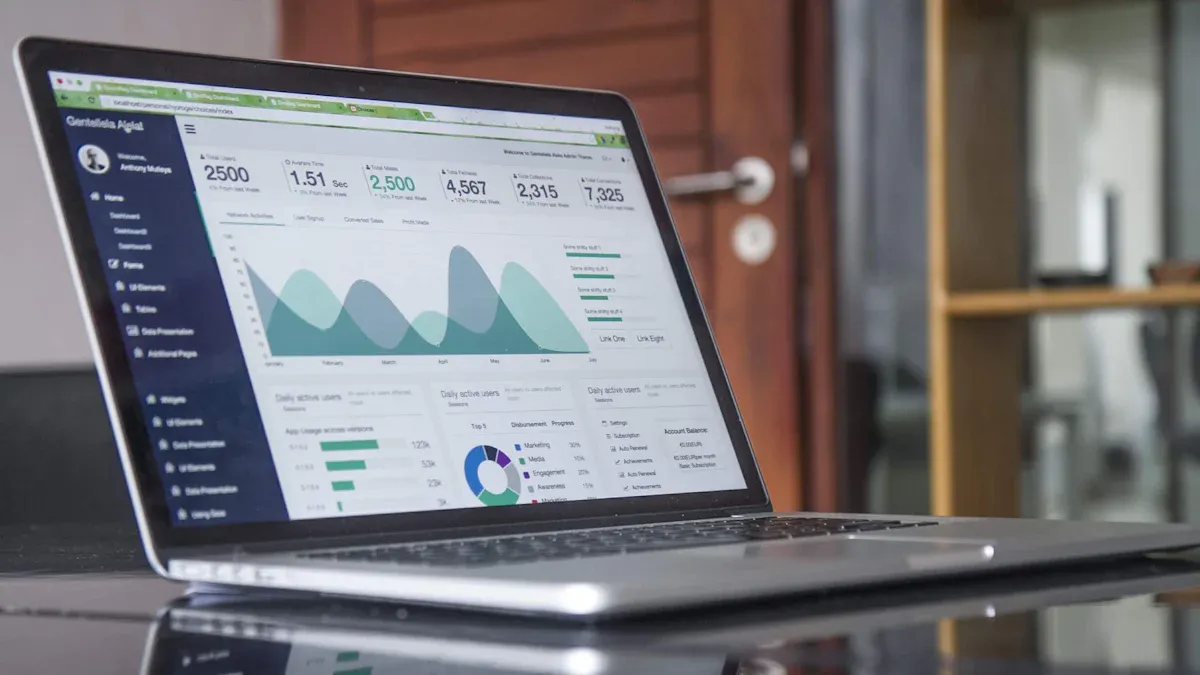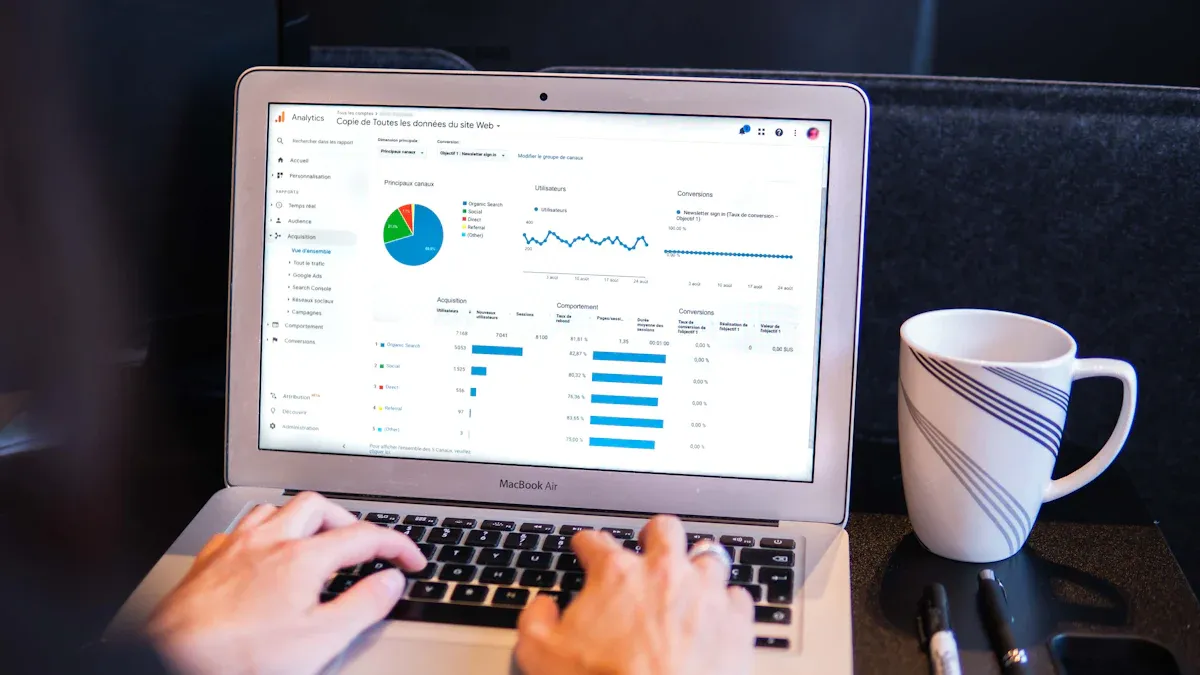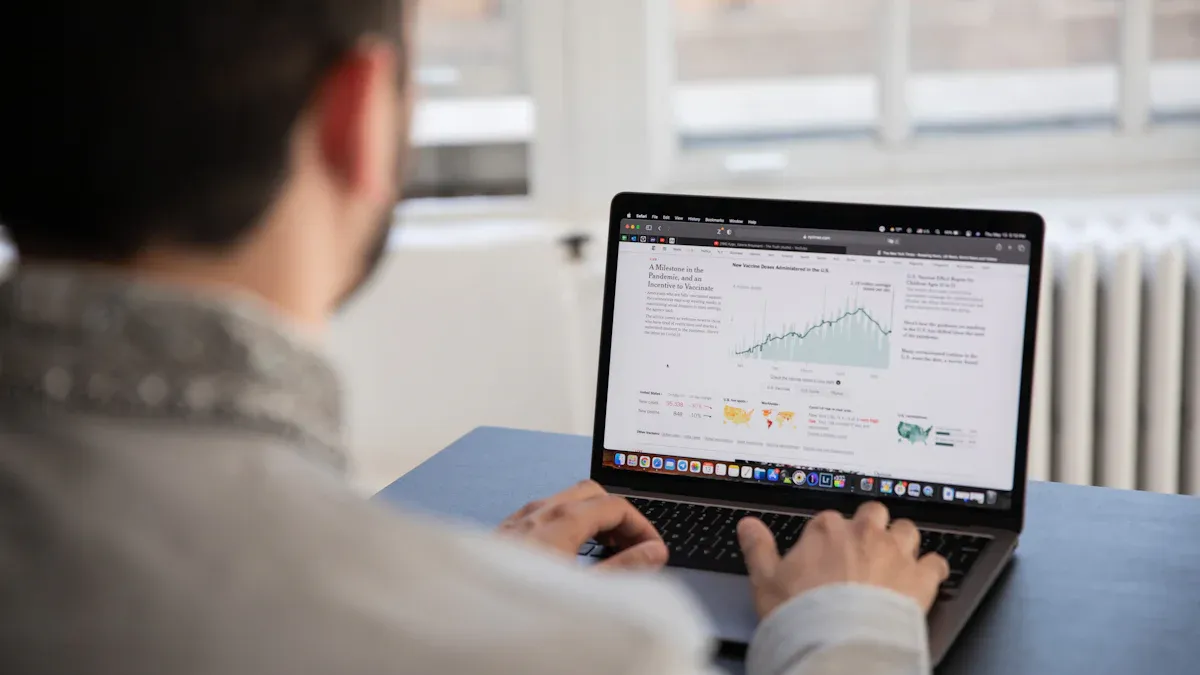
In today’s data-driven world, choosing the right data visualizer is more important than ever. Every day, approximately 328.77 million terabytes of data are generated, creating an overwhelming need for tools that can simplify and clarify this information. Studies show that most people are visual learners, making clear and effective visuals essential for understanding complex data. Whether you’re presenting to internal teams or external clients, the right visualization can transform raw numbers into actionable insights. By focusing on the 6-key-features-to-choose-a-visualizer, you can ensure your audience grasps the message without confusion.
Set your goals before picking a data visualizer. Clear goals help others understand the message you want to share.
Learn about your data type and how complex it is. Choose a visualization that fits your data for better understanding.
Think about what your audience needs and likes. Adjust your style so it connects well with them.
Test your visualizations and make changes. Create samples and get feedback to make them clearer and better.
Keep it simple and correct. A neat design helps people focus on the main ideas without getting confused.
Before selecting a data visualizer, you need to define the message you want to communicate. A clear message ensures your visualization serves its purpose effectively. For example, if your goal is to highlight trends or patterns, your visualization should focus on making those elements stand out. Without clarity, your audience may struggle to understand the insights you aim to share.
Studies show that poor data visualizations often lead to misunderstandings, which can result in poor decisions or even legal issues. To avoid this, always start by asking yourself: What is the primary question I want to answer? This approach keeps your visualization focused and prevents aimless exploration of data.
Data visualizations are powerful tools for driving decisions. They reveal trends and patterns that raw data often hides. For instance, a well-designed chart can help stakeholders identify opportunities or risks that might otherwise go unnoticed. By defining the decisions or actions you want to influence, you can tailor your visualization to guide your audience toward the desired outcome.
Research confirms that visual tools can narrate a data-driven story that is both insightful and actionable. For example, a heatmap showing customer activity can help a marketing team decide where to focus their efforts. Always think about the specific actions your audience should take after viewing your visualization.
Your visualization goals should support your overall objectives. For instance, if your business aims to improve team alignment, your visualizations should clarify goals and track progress. This alignment ensures that your visualizations contribute to the bigger picture.
Visualization techniques also help leaders foresee challenges and plan for different scenarios. By aligning your goals with broader objectives, you can enhance focus, improve performance, and manage risks strategically. This approach ensures that your visualizations are not just informative but also impactful.
Understanding the type of data you have is the first step in selecting the right visualization. Data can generally be categorized as categorical, numerical, or temporal. Each type requires a specific visualization strategy to effectively communicate insights. For example:
Data Type | Visualization Strategy |
|---|---|
Categorical | Bar charts |
Numerical | Line graphs |
Temporal | Line graphs (time series) |
If your data includes categories like product types or regions, bar charts work best. For numerical data, such as sales figures, line graphs can highlight trends. Temporal data, like monthly revenue, benefits from time series visualizations. By matching the data type to the right visualization, you ensure clarity and relevance.
The size and complexity of your dataset also influence your choice of visualization. Larger datasets often require more sophisticated tools to avoid overwhelming your audience. For instance, heatmaps and scatter plots are ideal for visualizing large volumes of data. These tools help you present complex information in a digestible format.
Assess whether your dataset is small, medium, or large.
Choose visualizations that balance complexity with clarity.
Avoid clutter by focusing on the most critical data points.
When working with large datasets, simplicity is key. A clear and concise visualization ensures your audience can quickly grasp the main insights.
Highlighting relationships and patterns in your data makes your visualization more impactful. Techniques like heatmaps, flow charts, and chronology charts can reveal trends, clusters, and connections. For example, a heatmap can show customer activity across different regions, while a flow chart can simplify complex workflows.
Visualization Technique | Description |
|---|---|
Heatmaps | Show patterns and clusters in data. |
Chronology charts | Analyze temporal patterns and changes over time. |
Flow charts | Depict processes and workflows for better understanding. |
By focusing on relationships and patterns, you can transform raw data into actionable insights. This approach aligns with the 6-key-features-to-choose-a-visualizer, ensuring your visualizations are both effective and engaging.
Understanding your audience is the first step in creating effective visualizations. Ask yourself: Who will use this data? Your audience could include executives, team members, or external stakeholders. Each group has unique needs and expectations. For example, executives often prefer high-level summaries, while analysts may require detailed breakdowns. Surveys or feedback forms can help you gather insights about your audience's preferences. These tools provide direct input, ensuring your visualizations meet their expectations.
Tailoring your approach to the audience ensures your message resonates. For instance, a live presentation might work best for a small team, while a detailed visual report could suit a larger, diverse audience. Knowing who will view your visualization helps you choose the right format and style.
Not everyone has the same familiarity with data. Some audiences may excel at interpreting complex charts, while others might struggle with basic graphs. Understanding your audience's data literacy level is crucial for effective communication. For example, a team of data scientists might appreciate scatter plots with detailed annotations. In contrast, a general audience might benefit from simpler bar charts or pie charts.
Matching the complexity of your visualization to your audience's skills enhances clarity and accessibility. This approach prevents misinterpretation and ensures your message is understood. Clear visualizations empower your audience to make informed decisions quickly and confidently.
Your audience's preferences should guide your visualization style. Some may prefer colorful, interactive dashboards, while others might favor minimalist designs. Consider their expectations when choosing colors, fonts, and layouts. For example, a marketing team might appreciate vibrant visuals that highlight trends, while a finance team might prefer clean, straightforward charts.
Different audiences also have varying preferences for how data is presented. Some may value interactivity, allowing them to explore the data themselves. Others might prefer static visuals that summarize key points. By tailoring your visualization style, you ensure your audience stays engaged and focused on the insights.
Tip: Always align your visualization with the 6-key-features-to-choose-a-visualizer to ensure it meets your audience's needs effectively.

Choosing the right visualization type depends on your data and the message you want to convey. For example, bar charts work well for comparing categories, while line graphs are ideal for showing trends over time. Heatmaps and scatter plots are better suited for large datasets, as they highlight patterns and relationships effectively.
Data Type | Recommended Visualization | Purpose |
|---|---|---|
Categorical | Bar Charts | Effective for comparisons |
Numerical | Line Graphs | Best for showing trends over time |
Temporal | Line Graphs | Ideal for time series data |
Large Datasets | Heat Maps, Scatter Plots | Show patterns in dense data |
Understanding your communication goals is equally important. If you aim to inform, choose simple visuals like pie charts. For persuading or inspiring action, interactive dashboards or detailed infographics may work better. Always align your visualization type with your audience's needs and your broader objectives.
Visualization tools vary in features, usability, and cost. Comparing them helps you find the best fit for your project. Here’s a quick overview of some popular tools:
Tool | Ease of Use | Interactivity | Integration | Customization | Performance | Cost | Community Support | Advanced Analytics |
|---|---|---|---|---|---|---|---|---|
Google Data Studio | High | Medium | High | Medium | High | Free | Large | Low |
Tableau | High | High | High | Medium | High | Subscription | Large | High |
Power BI | High | High | High | Medium | High | Subscription | Large | Medium |
D3.js | Low | High | N/A | High | Medium | Free | Medium | Low |
Plotly | Medium | High | N/A | High | Medium | Free | Medium | Medium |
Datawrapper | High | Low | N/A | Low | Medium | Free | Medium | Low |
For ease of use, tools like Google Data Studio and Tableau stand out. If interactivity is a priority, consider Tableau, Power BI, or Plotly. For advanced customization, D3.js and Plotly are excellent choices. Evaluate these tools based on your specific needs and budget.
Ease of use is critical when selecting a visualization tool. Features like drag-and-drop interfaces and intuitive menus make tools accessible to users with varying skill levels. Customization is another key factor. Tools like D3.js and Plotly allow you to tailor visuals to fit your data and goals. Integration capabilities are equally important. Power BI integrates seamlessly with Microsoft products, while Google Data Studio connects well with Google services.
A tool that balances usability, customization, and integration ensures efficiency and effectiveness. By focusing on these aspects, you can create visualizations that are both impactful and easy to manage.
Tip: Always evaluate tools against the 6-key-features-to-choose-a-visualizer to ensure they meet your requirements.

Prototyping is a crucial step in the visualization process. It allows you to quickly bring your ideas to life and test them before committing to a final design. Drafts help you identify potential usability issues early, saving time and resources in the long run. For example, a prototype can reveal if your audience struggles to interpret a specific chart or if the layout feels cluttered.
Prototypes also serve as a communication tool. They help you share your concepts with stakeholders and team members effectively. A real-world example from Eleken demonstrates how a prototype was used to validate ideas and gather feedback before full development. This approach ensures your visualization aligns with both your goals and your audience's needs.
Tip: Start with simple sketches or wireframes. These low-fidelity drafts are easy to create and adjust based on feedback.
Stakeholder feedback is invaluable for refining your visualizations. It provides insights into how well your design communicates the intended message. Feedback also highlights areas that may need improvement, such as clarity, accuracy, or relevance. Research shows that involving stakeholders early and often enhances communication and ensures the final product meets expectations.
To gather feedback effectively, share your prototypes with a sample of stakeholders. Observe how they interact with the visualization and ask for their opinions. Questions like "Is the data clear?" or "Does this chart help you make decisions?" can guide the discussion. Visual presentations of data make it easier for stakeholders to identify patterns and trends, which might be missed in text-based reports.
Note: Feedback is not just about identifying flaws. It also helps you understand what works well, so you can build on those strengths.
The iterative process is all about continuous improvement. Each round of feedback helps you refine your visualization, making it more effective and user-friendly. Teams often use trial and error to test different approaches and adjust their designs over multiple cycles. This method ensures the final product is polished and impactful.
Involve stakeholders at every stage of the process. Show them updated versions of your visualization and ask for their input. Testing with a small group can reveal how users interpret the data and whether the design meets their needs. Incorporate their suggestions to enhance clarity, accuracy, and usability.
Tip: Don’t rush the iteration process. Each cycle brings you closer to a visualization that truly resonates with your audience.
Overloading your visualization with excessive information can confuse your audience. When too many details are included, users may struggle to focus on the key message. Research highlights several negative impacts of overloading visualizations:
Negative Impact | Description |
|---|---|
Confusion | Users find it difficult to understand all details of the visualization. |
Lack of Focus | Users are unsure where to direct their attention. |
Difficulty in Deciphering the Message | It becomes challenging to grasp the message quickly. |
Overloaded Information | Including too much data makes the chart unreadable. |
Recommendation for Clarity | Limit data to what is most relevant and consider multiple visualizations. |
To avoid this pitfall, focus on the most critical data points. If your dataset is large, consider breaking it into multiple visualizations. This approach ensures clarity and helps your audience quickly grasp the main insights.
Accuracy is essential in data visualization. Misleading representations can distort your audience’s understanding and lead to poor decisions. For example, inaccurate charts may cause misconceptions that influence social trends. When audiences discover errors in your visualizations, they may lose trust in your organization.
To ensure accuracy, always double-check your data and consider how your audience interprets design elements. Misleading visuals often arise when creators fail to account for different perspectives. Accurate visualizations effectively convey your message without causing confusion.
Understand your audience to tailor your design appropriately.
Use consistent scales and avoid manipulating axes to exaggerate trends.
Present data honestly to maintain credibility and trust.
A clean and focused design improves comprehension and engagement. Research shows that combining decluttering with a focused approach makes audiences 2.5 times more likely to understand the main conclusion.
Technique Used | Effect on Comprehension | Notes |
|---|---|---|
Decluttering Only | No significant improvement in understanding | Participants found decluttered graphs more professional but missed key points. |
Decluttering + Focusing | 2.5 times more likely to capture main conclusion | Combining both techniques significantly enhanced the audience's ability to understand data. |
To achieve this, remove unnecessary elements like excessive gridlines or redundant labels. Highlight the most important data points using contrasting colors or bold fonts. A clean design not only looks professional but also ensures your audience stays focused on the insights you want to share.
Tip: Simplicity is key. A well-organized visualization communicates more effectively than a cluttered one.
Selecting the perfect data visualizer becomes easier when you follow a structured approach. By defining your goals, understanding your data, identifying your audience, exploring tools, testing your designs, and avoiding common pitfalls, you ensure clarity and effectiveness in your visualizations. This process helps you communicate insights more effectively and engage your audience.
A structured approach offers several benefits:
It ensures your visualizations align with your goals and audience needs.
It enhances clarity, making complex data easier to understand.
It improves communication by emphasizing key patterns and results.
Experimentation is key to mastering data visualization. Test different tools, refine your designs, and adapt to your audience’s preferences. With the 6-key-features-to-choose-a-visualizer in mind, you can create visuals that inform, inspire, and drive action,Visualiser for teaching.
The most important factor is understanding your goals. You need to know what message you want to convey and how the visualization will support your objectives. This clarity ensures your visualizations are purposeful and effective.
Match the visualization type to your data and goals. For example:
Use bar charts for comparisons.
Use line graphs for trends.
Use heatmaps for patterns.
Always consider what will make the data easiest to understand.
Yes, many free tools like Google Data Studio and Datawrapper are reliable. They offer essential features for creating effective visualizations. However, evaluate their limitations, such as fewer customization options, before deciding if they meet your needs.
Focus on simplicity and clarity. Use contrasting colors to highlight key points. Avoid clutter by removing unnecessary elements. Tailor the design to your audience’s preferences to keep them engaged and focused on the insights.
Avoid overloading your visuals with too much information. Ensure accuracy by double-checking your data. Keep the design clean and focused. Misleading or cluttered visuals can confuse your audience and reduce the impact of your message.